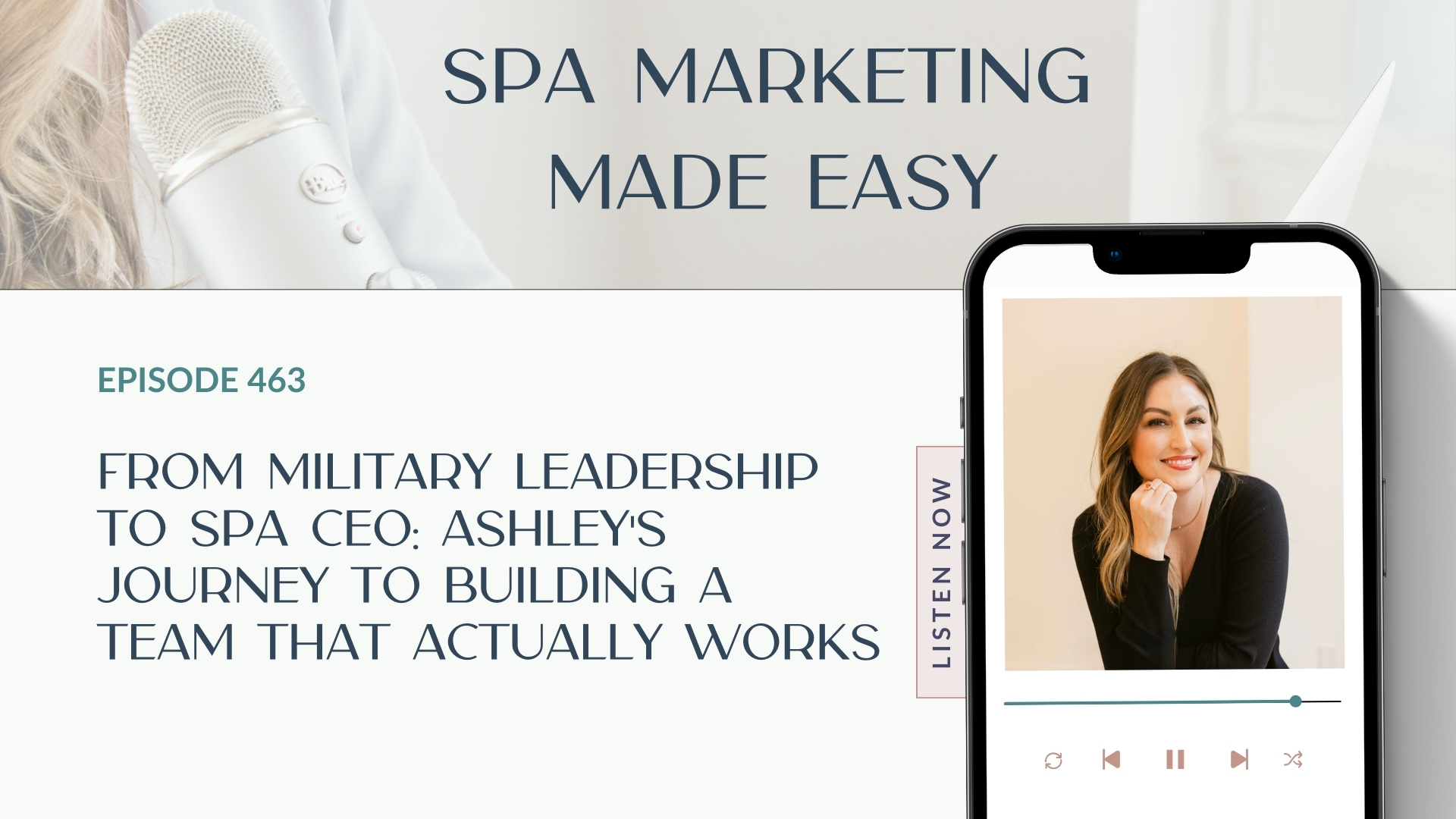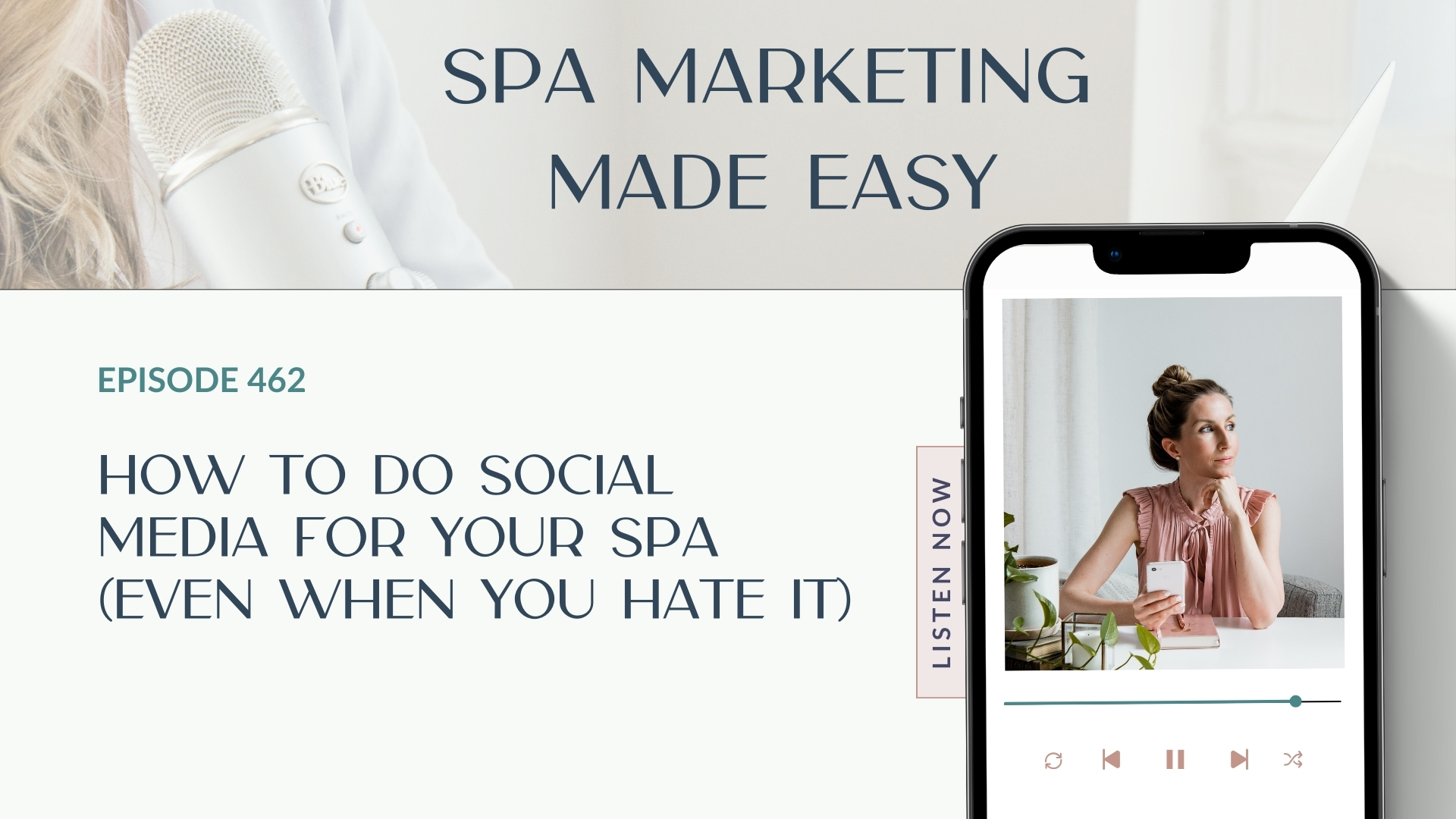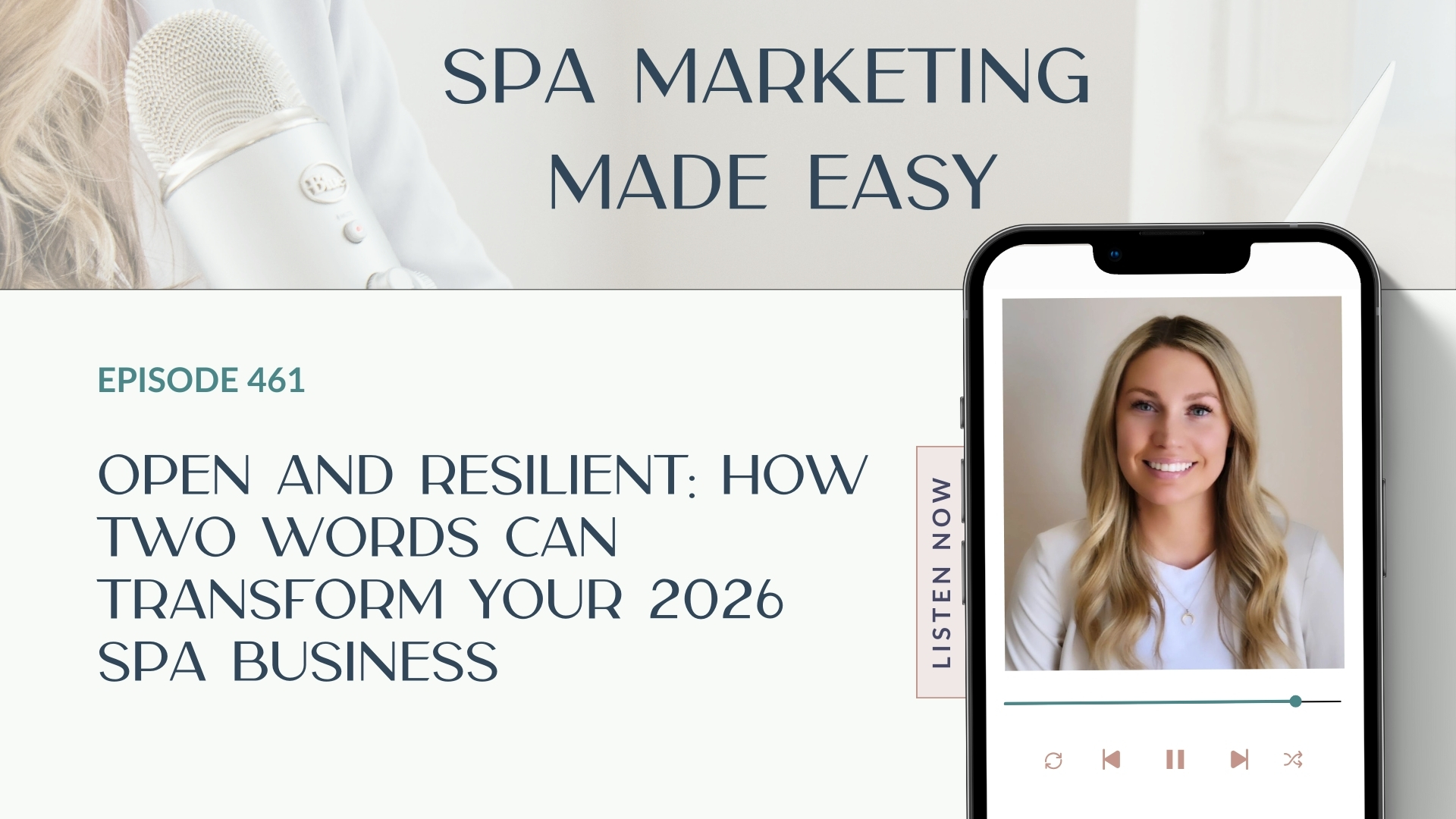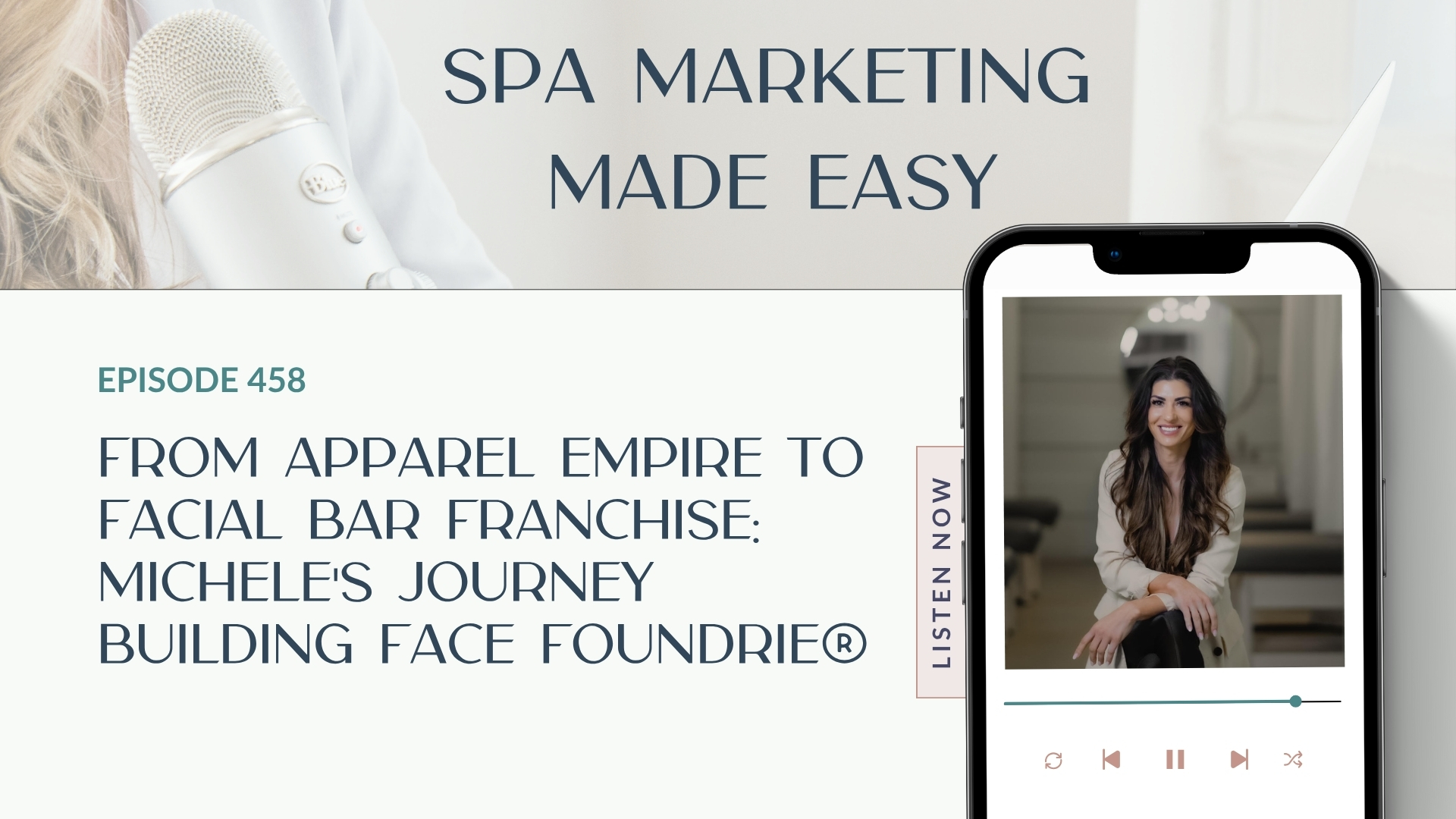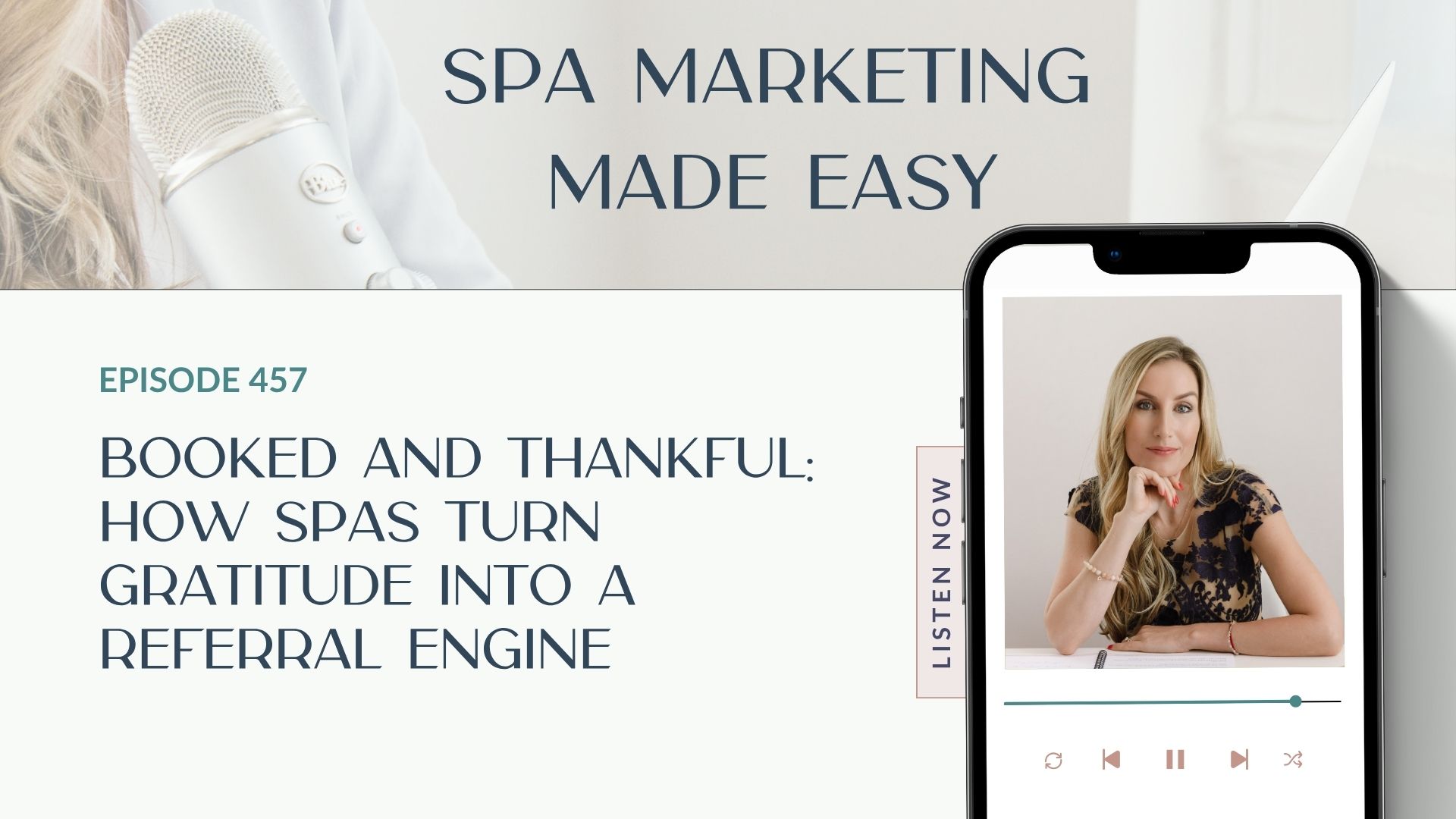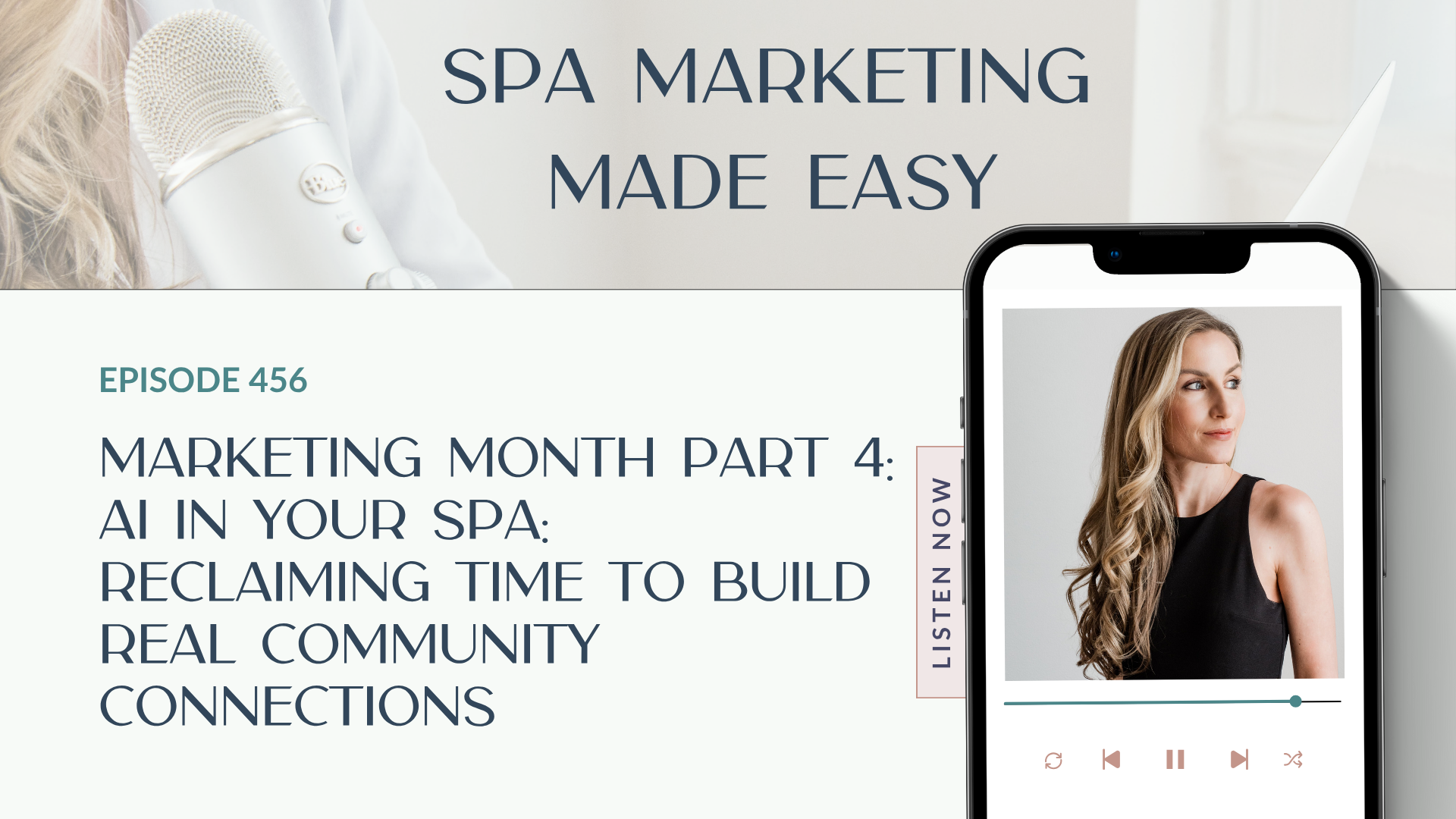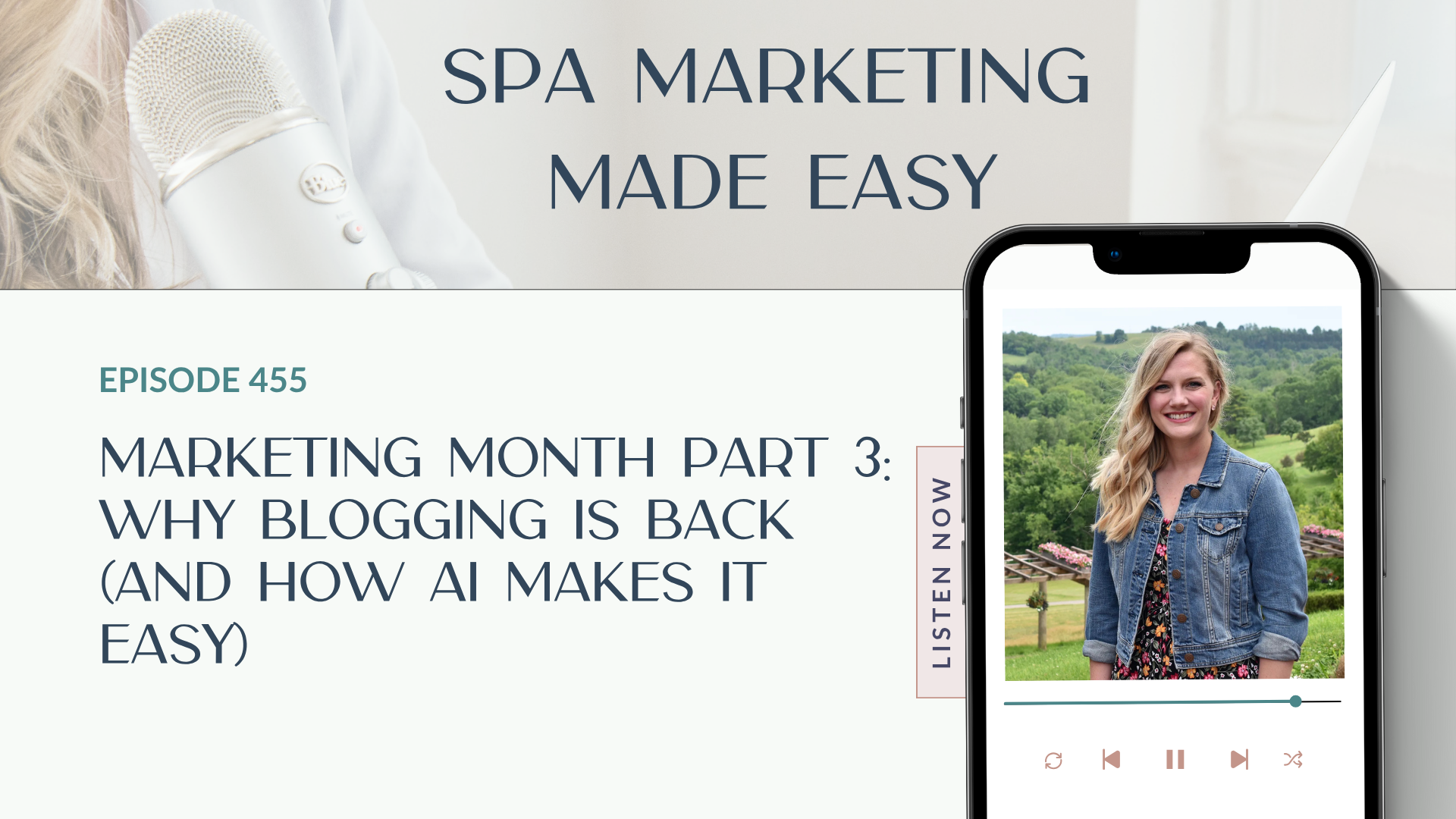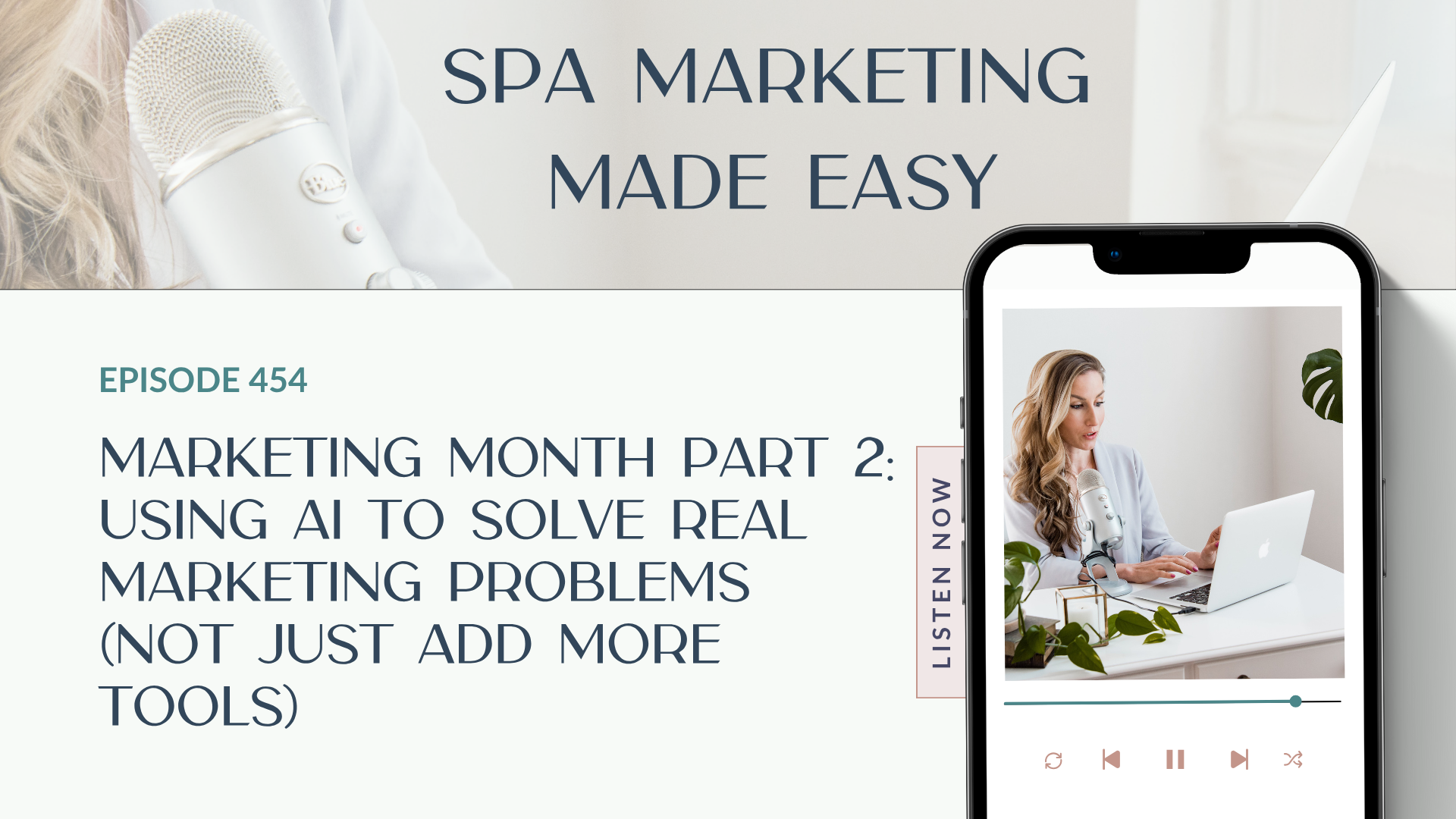The Unconventional Path to Exceptional Spa Leadership
If someone told you that military and law enforcement experience could be the secret weapon to building an incredible spa team, would you believe them?
In this episode, Daniela introduces Ashley, Addo’s newest coaching team member, whose journey from putting mud on her skin as a child to leading a successful spa business is as unconventional as it is instructive. And if you’ve been struggling with hiring, team turnover, or feeling like you’re the only person who can do things right in your business, this conversation is going to shift your entire perspective.
Because here’s what Ashley understands that most spa owners don’t: building a great team isn’t about finding perfect people. It’s about knowing exactly who you’re looking for, communicating clear expectations, and having the courage to protect your team culture at all costs.
When Your Comfort Zone Becomes Your Prison
Ashley’s story starts in an unexpected place. As a child, she would sit in the mud, cover her body, let it dry, and then buff it off, telling her mom how soft it made her skin. Neither of them realized she was essentially exfoliating and experimenting with skincare treatments.
Fast forward through military deployment where she showed up with an entire bag of skincare products, then into law enforcement where she was constantly advising people on their skin, and you start to see a pattern. But it took her husband sitting her down during a particularly dark career period to say the words that changed everything: “You either need to go back into law enforcement, or you need to find something else. You should go into skincare.”
The idea had never occurred to her. Like so many of us, she was taught you go to college, get a degree, and then get a job. The concept that you could actually have a career in a spa, that this could be your profession, was completely foreign. But within weeks, she was enrolled in aesthetics school, determined to work for a doctor or med spa.
She had no intention of running her own business. And yet, here she is, having built a thriving spa with a team that’s been together for years, and now coaching other spa owners on how to do the same.
The Accidental Entrepreneur Who Wasn’t So Accidental
What Ashley discovered when she started working in med spas is something many of you have probably experienced: she wanted things done a certain way. She wanted every client to feel seen and heard. She had standards that weren’t being met in the places where she worked.
She was an accidental entrepreneur, except she really wasn’t. Because at her core, she’s a leader. She takes everything seriously, not in a rigid way, but in a “this matters and we’re going to do it right” kind of way. That’s who she is.
So she started as a solo aesthetician in a tiny room. Then moved to solo salon suites and kept growing. Eventually, she was maxed out at capacity with a waitlist that nobody would leave. And she faced the choice every successful solo faces: stay comfortable at this level, or take the risk of building a team.
The Team That Actually Stayed
Here’s where Ashley’s story diverges from what we typically hear. Her very first hire, her assistant who became her spa manager, is still with her today. Megan went through Addo’s Spa Manager Certification program and is now leading the team. This is her unicorn, her ride or die.
Now, that doesn’t mean every hire has been perfect. Ashley is quick to clarify that she’s had team members who weren’t the right fit. But here’s the critical difference: she learned early how to identify misalignment, communicate clearly, and protect her team culture.
And much of that comes from her background in military and law enforcement, where leadership principles are taught tangibly. Accountability is clear. Expectations are communicated directly. There’s no room for blaming others or making excuses. You know what’s expected, and you’re held to that standard.
The Ideal Employee Avatar You’ve Never Created
One of the most valuable concepts Ashley shares is something she calls the “ideal employee avatar.” Just like you have an ideal client avatar, you need to know exactly who your ideal team member is before you ever start interviewing.
Sit down with a notepad and brain dump everything. Who is this person? How do they show up for clients? How do they speak to leadership? Are they willing to be on social media? What are their communication styles? What are their values?
Think of it like dating. You have your musts and your absolutely nots. You need to get crystal clear on who you are as a business, your mission, everything you stand for. Then ask yourself: does this imaginary person fit?
When Ashley and her spa manager hire now, they know exactly who they’re looking for. They’ve defined this person in detail. And then during the interview process, they’re simply checking for alignment. Does this real person in front of them match the avatar they’ve created?
The Scarcity Hiring Trap
Ashley admits her biggest hiring mistake early on was hiring too quickly from a place of scarcity. And this is something Daniela sees constantly in the spa industry: owners making massive decisions from emotion instead of strategy.
You’re overwhelmed. You’re maxed out. You desperately need help. So you hire the first person who seems decent because you need the relief now.
But that’s how you end up with team members who disrupt your culture, don’t align with your values, and ultimately cause more problems than they solve.
The solution? Never make big decisions from scarcity. Take the time to get clear on who you need. Be willing to wait for the right person rather than settling for the available person. And recognize the difference between intuition and emotion when you’re making these choices.
Core Values: Not Just a Checkbox Exercise
Here’s something most spa owners do wrong: they write down their vision statement, mission statement, and core values in a notebook during some business exercise, and then they never look at them again.
But as Daniela points out, your core values aren’t a KPI you track. They’re who you are. They’re like asking what color eyes you have. You should just know.
And every time someone doesn’t work out in your company, it’s a misalignment of values. Not skills, not experience, not qualifications. Values.
So when you’re hiring, you’re not asking “Will they go on social media?” You’re asking “Are they fully committed to doing whatever it takes to provide exceptional service to the client?” And if the answer is yes, then going on social media becomes part of that commitment.
Delegation Without Losing Your Mind
One of the running jokes in Ashley’s spa is that she’s not allowed to touch the booking software. Her brain works differently, and when she gets in there, things get messy. Her spa manager handles it.
And Ashley is completely comfortable saying to her team: “That’s a Megan thing. You don’t want me in there.”
Think about that for a moment. The owner and CEO of the business openly admitting there are systems she doesn’t handle because someone else is better at them.
This is what true delegation looks like. It’s knowing your zone of genius and protecting it fiercely. It’s hiring people who are better than you at specific things and celebrating that fact instead of feeling threatened by it.
Ashley has one esthetician on her team who is their bookworm, their science girl. When they’re considering new product lines, Ashley does the initial research to make sure it aligns with their values and goals. Then she hands it to this team member and says, “Here’s what I’m thinking. Give me the green light.”
She’s empowering her team to excel in their zones of genius while she focuses on hers.
What This Means for Your Business
If you’re stuck in the treatment room as the primary revenue generator, if you’re afraid to hire because you’ve been burned before, if you’re exhausted from doing everything yourself because “it’s just easier,” this episode offers a different path forward.
Building a strong team isn’t about luck. It’s not about finding unicorns. It’s about knowing exactly who you’re looking for, communicating clear expectations, hiring from strategy instead of scarcity, and being willing to protect your team culture even when it’s uncomfortable.
Ashley’s journey from military leadership to spa CEO proves that the skills you need to build an exceptional team can be learned. And now, as part of Addo’s coaching staff, she’s helping spa owners develop those exact leadership capabilities.
Your business will only grow as much as you’re willing to grow as a leader. And that growth starts with getting honest about what you need, who you need, and what you’re willing to do differently.

Subscribe to Our Newsletter
Stay up-to-date with our email newsletter to receive important updates, news, and offers!
IG / @addoaesthetics
WEB / addoaesthetics.com
YOUTUBE / @addoaesthetics
LINKEDIN / @addoaesthetics
About Your Host, Daniela Woerner
Daniela Woerner is the founder of Addo Aesthetics and creator of the Growth Factor® Framework, a proven system that’s helped hundreds of spa owners build profitable, systemized businesses. With nearly 20 years in the aesthetics industry, she transforms overworked aesthetic professionals into confident Spa CEOs through strategy, systems, and soul led support. Daniela is also the host of Spa Marketing Made Easy, a top ranked podcast with over 1 million downloads, where she shares real world strategies to help spa professionals grow with clarity and confidence.
PODCAST TRANSCRIPT:
All right, Ashley, welcome to the Spa Marketing Made Easy podcast. This is the first Hey, we have tried to get you on this show before. Yes, and you said
No, because it was a little bit of nerves, little
bit of nerves. But now I’m so thrilled that we’re actually introducing you as a member of our team, and I feel like that was just in the cards. You know, we’ve worked together for years, and there’s always people that you just have, like, a connection with. And I feel like we always had that from the beginning. You the very first time I remember us working together. Was the RA day we did a revenue accelerator. It was like, online, four hours getting into it. And I still remember, I was like, Oh, I really like this girl. I was like, these are fun when, like, when you get amazing people, it’s like, that just feels so fast, like the time goes so fast, and so we have kind of worked together and grown together for several years, and now we’re in this, like next stage, or next phase of our relationship, where you worked yourself out of your spa, You know, you’ve got an incredible team doing great things, and you were ready to kind of take on a new opportunity and challenge, and so we invited you on to our coaching staff, and I really wanted to use this opportunity to just kind of share with the rest of our community your story, what You’re about, and let them get to know you as you know as I know you. So welcome. And, yeah, where do you want to start? Like, let’s start. Like, how did you get into this industry in the first place? Like, let’s start there. Because you have a really interesting path that I mean, you’re not the only one with military and law enforcement experience. Like, it’s surprising, but there are, like, a handful of them out there. But, like, how did you start with a path like that? That’s, you know, very kind of law enforcement and military are aligned, right? Oh, yeah. But then you went into spa
like, yeah, it’s a, it’s a very interesting story. So a part of my past and my story I didn’t even realize was in the making most of my life, until as I’ve become a little more in tune with myself that it was, it was always, it was always there. So we there’s this, there’s this time that where my mom used to say, what are you doing out in the yard? What are you doing out in the yard? And I would be sitting out in the mud, and I would be putting it all over my body and letting it dry, and then I would, like, buff it off. And I would tell her, I’m like, it makes my skin so soft. It makes my skin so soft. And neither one of us clicked, you know what I was doing? And so, you know, I laugh about it now, because I’m like, I was exfoliating. And I would tell everybody, like, put mud up. Put mud on your body. And then fast forward to the military. I’ve always been very patriotic. It was just part of something I really wanted to do, but I still definitely had that girly side to me. And I was randomly deployed, like unexpectedly turned into a very long deployment, and I had just gotten to my command, so I had no idea what I was doing, and I’m walking, I was in a squadron, but I’m walking up to this to my carrier to get on, and I had these massive bags.
This is like a core memory for me, and I could hear people in the background saying, Where does she think she’s going with all this stuff? And I had like an entire bag of skincare with me, again, like I’m not knowing the ship or the ship, and we have like, these really tiny little compartments, and, you know, there’s one in the middle that’s huge, and that was, like, all my skincare and makeup, and so it just the whole time there I was always, you know, that girl, I was very I did all my things, but I like to take care of myself. And then I went into law enforcement. Same thing. I was telling people what to do with their skin, all the things. Fast forward, we ended up moving to Washington State, and I was going to Laurel to be a police officer here, and I just decided we wanted to start a family. I wasn’t sure if that’s kind of what I wanted to do. And I tried another career path, and it was awful. People I knew were doing it, succeeding, doing amazing things. And I thought, like this cool, I want to do this. And it just became a really awful time in my life, a very dark time. And my husband sat me down, and he said, you either need to go back into law enforcement or you need to find something else, because I want my happy. Wife back, and so I was like, I don’t know what to do. And he said, You should go into skincare like, God knows, you spend all our money there, and you’re constantly telling people what to do with their skin. And I don’t think I realized at that moment that that was a fork in the road for me, but I
did, you even know about that? Because I felt like, for me, I was always taught, like, you go to college and then you get a job, like, that’s what you did. And I went to college, I graduated. I did, you know, the four years I took five years, but took five years and then, like, within months of graduating, I enrolled in esthetic school.
Yeah, I had no idea either that it was like a thing, yeah? I was like, you
can actually have a job that you’re in a spa all day, like, that’s your job?
Yeah, I got treatment. So I don’t know where the disconnect of like that is a job came from. But no, I went to the military. I was in law enforcement. I have my four year degree. I’m very type a very driven, and I just It never occurred to me until my husband, who knows me better than anyone, was like, This is what I think you should do, or go back into law enforcement, because I did enjoy it, and I searched out the best schools. I was enrolled a week or two later, and went, got my Master’s static license, and I told myself, I want to either work for a doctor or in a med spa. I did not want to run my own business, and I went and worked in the med spas, did all the things. And I realized that I think I actually wanted to do this. I think I was an accidental entrepreneur, but it was, it’s who I am at my core, because I take everything so serious, not seriously in a bad way. But I want it. I want it to go a certain way. I want everyone to feel very seen, very heard. And I just started as a solo esthetician and just a tiny little room, and grew, and then I did a solo salon suites and kept growing. And I was I was maxed out. I was at capacity. And it was either okay, this is where I am and this is who I’m going to do, or I’m going to grow a team. And I had my assistant at the time, and we we kept trying to get people off the waitlist, the wait list, and nobody would leave. And so I was like, Okay, I want to impact more people, and I love a team. I like being surrounded by other people. And so that’s what I did.
So what year was it that you started your spa?
So I my brick and mortar. We opened in 2021 so right after covid,
that was you as a solo, or that was your build out for your
build out. That was my build out, yep. And I was a solo in 2017
2018 Okay, and so you did the solo thing for quite a while before you really started getting into the build out. And when you did the build out is that when you hired your staff? Yes.
So I had my assistant, who’s now my spa manager, and she’s she’s been with me, my ride or die, my unicorn, for a very long time. She’s actually been through the spa manager training with Addo, and so now she’s a spa manager, but she was my very first hire.
Wow, that is not something that you hear every single day, because I will often teach, because I want to normalize it that, like building a team is hard, and that’s where, you know, I see a lot of solos will get up to that, like 25 to 35,000 mark, and they get stuck because they’re the primary revenue generator. They’re the one in the room doing everything. They’re not willing to hire a spa manager yet because they don’t feel that they’re ready. And they get stuck at that $30,000 mark. But it’s this like catch 22 because they don’t have the systems in place to slowly get them out of the room and slowly hire an onboard staff. They’re not going to hire other people. And so we see so many people get stuck. So when they do hire a lot of times, their team will turn over 234, times because they don’t know how to lead. They don’t know what they need. They don’t know, you know, women, the majority of us are people pleasers. The majority of us don’t know how to clearly communicate in a leadership position. You know what the expectations are in a role, and that’s something that is a skill to learn. So the fact that Megan’s been with you like. From the beginning, for so many years, you have obviously, like an internal leadership quality. But I, I would argue, and I think you would agree, that, like obviously military and law enforcement, there’s a lot of leadership.
That’s it. There is, and I was a supervisor and leader in the military, and then obviously led in certain aspects in law enforcement. I think it’s just, it’s just what we do and who we are.
I i will never forget when I first read Extreme Ownership, and I was like, Oh my gosh, this is the most amazing. You know? I’m like, they’re giving, like, tangible things that are, like, leadership principles, and it makes so much sense. And I like, I bought the tickets. I went to muster, which is the conference that Jocko and Leif put on. I brought Kyle with me. I’m like, Kyle, you’re gonna love this. This is gonna be so amazing. And we go to the conference and they’re going through essentially the principles. And he’s like, Yeah, I mean, this is what I’ve been taught for the past 21 years. And I was like, what
you’re holding out on secrets? I was like, Why? Why is this? And he’s like, Yeah, we hear this all day every day for the past
21 years. And I was like, Okay, great. Well, I haven’t, because I was never in the military, but it’s they do a good job of teaching tangible leadership principles, because leadership is kind of a squishy skill to teach, right?
It really is. And also, I will say too, it’s, it’s taught me how to hold people accountable and clearly communicate to people my expectations and how to make them the best version of themselves through my communication. And that was something that I did learn in the military, because we we knew what was expected, and in law enforcement, we had accountability in our role. We didn’t get to, you know, blame it on somebody else, or or anything like that. It was, there was clear expectations. And I think that’s really helped too, as we’ve as we’ve grown
So 2021 you do your build out brick and mortar, hire your staff, go through the kind of post covid Boom and all that fun stuff. What was your greatest like? What were you the most proud of between the you know, over the past four years, five years that you’ve gone through
that, I think what I honestly, what I’m most proud of is my team. A lot of things that I do here in our communities in Addo is, is there is that fear of hiring, or there is, I’ve hired the wrong person and now what, and it’s either the now what, or it’s the I’m never going to do that again. And I think to fully understand it’s okay to figure yourself out and to figure out your team, and it’s a small business, we’re allowed to have the team that we want to have. And I think through interviewing and setting those expectations out, from phone interviews to the in person interview to the practical really does allow us to find who our people are, and to say that I haven’t had employees that it wasn’t a good fit, is not true. But I think in the beginning, learning and being able to communicate what we want out of our team and how to fix those challenges that are brought up to us, really, right?
I mean, it would be strange if you didn’t have some, you know, in there and and it doesn’t like, just because someone’s not a good fit for your company doesn’t mean that they’re not a good candidate. They can write an incredible person. And there’s just, like, a cultural misalignment. And I think oftentimes that can be no matter how much vetting you do. I mean, that’s why we have the 90 day probationary period, right? Because you can learn so much based on the phone interview and the in person and, you know, even the practical but it it takes really spending time and being in the same presence as somebody, see how they operate, to see what happens when challenges come up, to be able to say, You know what, they’re maybe not aligned with us, and that’s okay, you know? That’s okay.
And taking some personal ownership too, as a leader for my spa manager for for myself, is really getting to know people, their learning skills, their communication skills, and knowing that not everybody’s the same, and that’s okay, and allowing them to shine with their zone of expertise. And I think that’s really where my my team right now, is incredible. People. Everybody has their zone of expertise. Everybody communicates slightly different. We have our standards that are non negotiables, so that we’re all on the same page, but but knowing that you know, Esthetician, a spa manager, everybody communicates slightly different. And being able to show up for them how they deserve to be shown up for as well, because it is a two way street. I truly believe that we are, we’re a unit.
So tell me what your team looks like now. How many providers do you have? Versus administrative? What is the kind of overall structure of it?
So there’s me. I’m no longer in the room. I was I still do hands on training with them and guidance. And then we have four estheticians, my spa manager, my front desk, who also, one of her collateral duties is social media, so she helps me a lot with that. And then I have a VA and a medical director. Both my VA and my medical director are contractors, so they’re like the core of my team. And then, of course, when you’re thinking of like your org chart, I have my finance people, all you know, attorneys, you know outside people that were also in marketing, those kind of things.
But I call them your internal, internal advisory team, the the attorneys, the CPAs, the financial advisors. Those are all really important people that you even if they are contracted outside services, they are a part of your company. I mean, they’ve got to know intimately, like your goals and your vision.
So they’re definitely a part of the team. I mean, I wouldn’t be where I am without those people you know you’re you’re dealing with marketing coaches, your tax your financial attorneys, all those people really do make you who you are, and they can catapult you to the next level. And that’s the role of the
CEO is like knowing, hey, where am I smart and where do I need to bring in people that are smarter than me. Absolutely. We had the the kickstart accounting call, and Daniela Hayden, who’s the founder, she was like, Look, I didn’t go to school to be an aesthetician. You didn’t go to school to be a bookkeeper. So like, Why do you think that just because QuickBooks puts it there that, you know, the like, big picture strategy and and so often that’s one of the things that people are trying to do themselves, right? But there’s like, entire majors that are dedicated to like, how do I how do I bookkeep appropriately? How do I make sure that I’m doing this appropriately? So it makes sense, I believe very much in our role as CEO is to facilitate and lead a team of people that we are pouring into to be exceptional in their particular role. You know, yeah,
And that makes me. It really does just make me so happy. And I think a lot of entrepreneurs, which I feel like our community, are type A and we are so used to having our hands in everything. We started out as practitioners, and now somehow we are running a business. And I think somehow this happened to us. It happened for us, but we have to take a step back. And I’m speaking from experience of we don’t have to know everything. You know. You say it so well. It’s like we just have to know enough to be dangerous and to make sure we’re hiring the right people. And I do think once I let go of so many things and started delegating. Is my personal life changed. My anxiety levels dropped, and now it just makes me so happy to delegate and to have people in in my back pocket who that is, Arizona genius, even my estheticians, like I have one girl on my team, and she is just our bookworm. She’s our science girl. We’re getting ready to start a little series called Science Sundays, and she gets into the nitty gritty. And so now, if we are bringing on a product line, I do all the initial, you know, looking in, making sure it aligns with us, but then I bring it to her, and I’m like, Hey, here’s what I’m thinking. These are the products. I give her, the stuff, and then she is going to give me that green light. And so I think being able to know, like some people on your team, it’s okay that they’re they know more than you, and they’re better than you, and encourage it, and we’re all functioning at a different level. And that’s that’s great. It’s where the magic happens.
It was a big milestone for me, because being the type A and going, you know, like I used to feel that I had to know the answer to everything. And I was like, if I’m coaching, they’re gonna ask me, and I need to, I need to know the answer. And now. One of my greatest things is like, I have no idea what that answer is, you know, and I’m very comfortable saying that. But that took, that was, like a big milestone, to be able to have a level of comfort in what is my zone of genius and what do I have no idea about, and just be very comfortable and at peace not knowing the answer because it doesn’t make sense. That’s not where I excel, you know, whatever that thing is. And so I’m going to focus all my time and energy on the things where I do Excel. And I think that we have to get comfortable with that, and it’s it’s very uncomfortable to not know the answer. We are taught that we’re supposed to well, if I don’t know, I can find out for you. And if I don’t, and to a certain degree, yes, but it’s more as a CEO, it’s well, if I don’t know, let me find a person who that is their zone of genius. Instead of let me find out and learn the answer. It’s like, Who can I talk to about this?
Right? One of, like, an ongoing joke in my spa, and everyone knows it is, you know, Ashley is not allowed to touch the booking software. Like, I make a mess of it, and I just because my brain is just different. I’m in there, like, and so my spa manager, that is what she does. And so now the team, because very long time I’m like, you guys know that’s a Megan thing. That’s, you know, our spa manager. And now they all just know to go straight to her. And it’s like, I might be the owner, the spa CEO, but you don’t want me in this trust. This is not where you want me unless you want things to go crazy. Like I can look at it and run the reports and make sure it’s all aligned, but when I start messing around in there, you don’t want it. And so I think telling people, letting people do what they are best at, is ideal for everyone. Last year
For Christmas, Sarah got me a shirt that said, I just work here. Yeah?
Because there were so many like, things would happen in the and I was like, because Christy really is, like, she runs a lot of the show, yeah? And I was like, that’s a Christie question. I just work here.
That’s what I say. I’m like, that’s a Megan thing. I’m not sure, like, what happened with this protocol? Um, let me check with the esthetician, because, you know, I just created it. Let’s make sure it’s going okay with them.
But I to, I feel that we are so blessed to be able to be in this position. There’s a lot of people that are going to be listening and saying, but like, but there’s just no good people, or there’s just no like, what? How do we help them to get to the place where they go from maybe those not correct hires. I don’t want to say bad hires, because I really believe that there are more good people out there than bad. I think it’s we don’t have the right people in the right positions, and we’re not attracting the right people. They’re all of us started as employees somewhere right and we have grown and built these incredible businesses. And so it’s like, how do we get self aware enough to understand what we need and then be able to communicate that so that we can go on this trajectory? You know, I had someone just message me on LinkedIn, and she’s like, Where do I even start? How do I create systems? How do I and I was like, Okay, I’m gonna send you some podcast episodes, because that’s like, a big that’s a big question. It’s a big it is, but, and it’s never ending, right? Because you get to, it’s new level, new devil, right? You solve one problem, you get to a new level of business. You might be stuck at the 30,000 but then you get stuck at 50, and then you get stuck at 80, and then you get stuck at 1.5 there’s these tiers that you’re solving different things, where at 30, maybe you need a spa manager, and you need, like, actual systems in place. Right at 50, you need a sales system in place that’s a clear, ongoing, consistent lead flow. At 80, it’s team issue. Yep, right. So we’ve got these different milestones that we’re hitting, but to even get to that next one. So much of it is personal development, so much of it is having tough conversations. So much of it is doing things that make you uncomfortable and falling flat on your face like almost everything that goes wrong in my company is my fault. I.
That Taylor Swift song. I I’ve sang it a few times through the Spa. I am the problem. But I think that’s the nice thing, is I definitely tell people like, oh, that, that was me, my I’m sorry. How are we going to fix it? I Yeah, so can you repeat the question real quick on that?
Yeah, I just, I guess, I just want to know, like, what were the
like you started, how to find the right person,
yeah, how do you get into, how do you get through those different levels? Like, when you’re going through, when you are taking those risks, when you have those moments that you fall on your face, because there’s people that are again in that beginning, and they’re like, I’m getting the wrong people, and I’m stuck in this catch 22 I’m in this cycle that I’m not going so, like, I don’t know if it’s a motivation question, I don’t know if it’s a self awareness question. I don’t know if it’s a like, strategic question.
I think it’s a little bit of strategy and internal work. I think one of the biggest things that I I’ve seen people do, and my biggest mistake in the very beginning, not with Megan, but with my next hire, was I hired almost too quickly, and it was coming from a place of scarcity. And I think you should never make these really big, ginormous decisions on emotion. Now I think we have intuition, and then we have emotion, and so that, I think not making these choices on on scarcity. And then the biggest thing that we do now, that I did not do in the beginning, was really sit down and think about, who is this person, who? What? What do they their emotions like, what? How do they show up for clients? How do they speak to leadership? Are they willing to be on social media? I mean, just brain dump it in on a notepad. This role, this is who they look like. So it’s kind of like our ideal client, right? Your avatar? I think having an ideal employee avatar is a thing. That’s a thing that just came to me right now. But and then it’s kind of like when you’re dating too. You have your your must and your absolutely nots. And I think really getting clear on who you are as a business, your mission, your just everything you stand for. And does this imaginary person right now fit in with that? And then now you have that, and while you’re doing the interview process, do they align with that? Because we can ease the skill we can’t always I I protect my team. They are my family. And if I bring someone in that disrupts that, I can’t do that. So now I’m I’m very protective, and my spa manager and I have really created who is this person, and how do they show up, and then that, and that’s what we’re portraying in our job posting, when in our check in emails that were when we’re reaching out, it’s when we’re doing the phone interview. These are the things that we’re trying to just really see if we align
so on a you’re getting a little more granular, but when I look at it at that. That’s your core values as a company. So you can have core values as an individual, like, what is your own belief system? But when you’re trying to hire, you’re finding someone whose values align. It’s not like, will they go on social media? It’s, are they going? Are they fully committed to doing whatever it takes to provide exceptional service to the client, right? Like, right? And that means this, this and this. And so
it’s results for us. So what are going to get the results? And these are the things that you need to do to get results.
Yeah. So absolutely, anytime you have someone that doesn’t work in your company, it’s a misalignment of values, absolutely. And so there’s this, you know, we we learn about this in business. 101, what’s your vision statement? What’s your mission statement, what are your core values? And most people write them down and never look at them. And it’s like, you know, we never
used it was a check in the box I wrote in a notebook. I’m gonna have to look it up. I’m like, This is not a KPI. This is like, who you are, yeah? Like, What color eyes Do you have, or what it’s like a, yeah,
you should just know piece of who you are. And everybody has them, even if you don’t have them defined. Like, that’s the thing.
So, I think just finding people that align with who you are and what you want, for your clients, for your business, and not doing it out of scarcity, that’s such a great lesson, and taking high advantage of the 90 day probationary period, yes, it is doing. Having, you know, weekly check ins, having those KPIs, but setting them up for success as well. Don’t just something really important is not just hiring somebody to mandate a problem, but we actually need to pour into them for them to be successful, because at the end of the day, they’re they are an employee, and they’re here, and they need your guidance. So we can’t just expect people to come in and create miracles like we really do have to pour into them and train them.
Yes, so true. Yeah, awesome. Well, I’m so happy to introduce you to the Addo community on a bigger scale. I know so many in our growth collector community know you very well, but now in the entire adult community, welcome to the family and so happy to so happy to have you and really help those that are struggling with hiring that are struggling with team. I mean, you obviously have a ton of experience in a variety of different ways, but this is really kind of your niche that you’re focusing on, is leadership, team, development, all of those things. So we are thrilled to have you, and
I’m so happy to be here. Gonna be an awesome year.
Yes!
